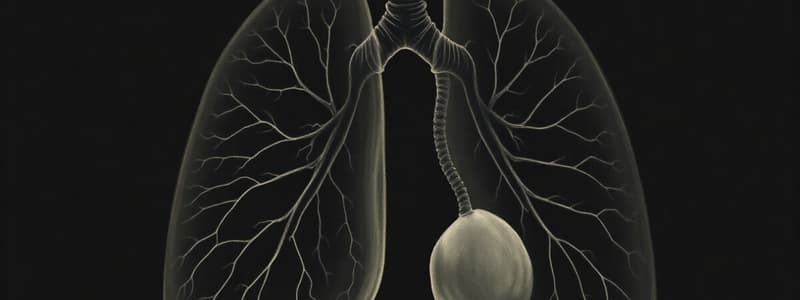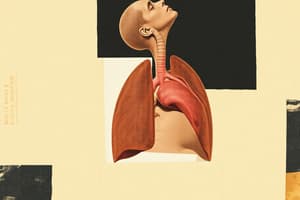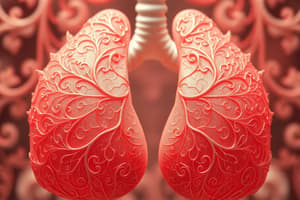Podcast
Questions and Answers
Which embryonic germ layer primarily contributes to the epithelial lining of the respiratory system?
Which embryonic germ layer primarily contributes to the epithelial lining of the respiratory system?
- Mesoderm
- Exoderm
- Endoderm (correct)
- Ectoderm
Around what gestational week does the initial formation of the respiratory diverticulum (lung bud) typically commence?
Around what gestational week does the initial formation of the respiratory diverticulum (lung bud) typically commence?
- Fourth week (correct)
- Eighth week
- Second week
- Twelfth week
From which primary structure does the respiratory diverticulum (lung bud) originate during embryonic development?
From which primary structure does the respiratory diverticulum (lung bud) originate during embryonic development?
- Foregut (correct)
- Midgut
- Hindgut
- Yolk sac
What is the alternative term used to describe the 'lung bud' during the early stages of respiratory system development?
What is the alternative term used to describe the 'lung bud' during the early stages of respiratory system development?
The respiratory diverticulum develops from the ventral wall of the foregut. What is the significance of this positioning in the developing embryo?
The respiratory diverticulum develops from the ventral wall of the foregut. What is the significance of this positioning in the developing embryo?
During lung development, which of the following processes is LEAST directly influenced by the transcription factor TBX4?
During lung development, which of the following processes is LEAST directly influenced by the transcription factor TBX4?
A neonate is diagnosed with esophageal atresia. Which of the following developmental processes most likely failed to occur properly?
A neonate is diagnosed with esophageal atresia. Which of the following developmental processes most likely failed to occur properly?
A premature infant is born at 25 weeks gestation and is experiencing significant respiratory distress. Which of the following developmental events is MOST likely deficient in this infant?
A premature infant is born at 25 weeks gestation and is experiencing significant respiratory distress. Which of the following developmental events is MOST likely deficient in this infant?
A fetus is diagnosed with congenital diaphragmatic hernia. Which of the following is the MOST direct consequence of this condition on lung development?
A fetus is diagnosed with congenital diaphragmatic hernia. Which of the following is the MOST direct consequence of this condition on lung development?
Which of the following events occurs during the terminal saccular period (26 weeks to birth) of lung maturation?
Which of the following events occurs during the terminal saccular period (26 weeks to birth) of lung maturation?
A child is diagnosed with a congenital lung cyst located at the periphery of the lung. This abnormality most likely resulted from:
A child is diagnosed with a congenital lung cyst located at the periphery of the lung. This abnormality most likely resulted from:
A physician is examining a newborn with respiratory distress. The infant's history reveals oligohydramnios during pregnancy. Which of the following lung development abnormalities is MOST likely associated with this condition?
A physician is examining a newborn with respiratory distress. The infant's history reveals oligohydramnios during pregnancy. Which of the following lung development abnormalities is MOST likely associated with this condition?
An autopsy of a stillborn fetus reveals an abnormal mass of lung tissue located within the esophagus. This finding is MOST consistent with which of the following developmental errors?
An autopsy of a stillborn fetus reveals an abnormal mass of lung tissue located within the esophagus. This finding is MOST consistent with which of the following developmental errors?
During which period of lung maturation does lung tissue become highly vascularized, and terminal bronchioles divide to form respiratory bronchioles?
During which period of lung maturation does lung tissue become highly vascularized, and terminal bronchioles divide to form respiratory bronchioles?
A researcher is studying the formation of the pleural cavity. Which of the following germ layers directly contributes to the formation of both the visceral and parietal pleura?
A researcher is studying the formation of the pleural cavity. Which of the following germ layers directly contributes to the formation of both the visceral and parietal pleura?
Flashcards
Respiratory system germ layers
Respiratory system germ layers
The respiratory system arises from these two germ layers during embryonic development.
Respiratory development start
Respiratory development start
The respiratory system starts its development around this week of pregnancy.
Respiratory diverticulum
Respiratory diverticulum
An outgrowth from the foregut that develops into the respiratory system.
Lung bud origin
Lung bud origin
Signup and view all the flashcards
Foregut
Foregut
Signup and view all the flashcards
TBX4
TBX4
Signup and view all the flashcards
Tracheoesophageal Septum
Tracheoesophageal Septum
Signup and view all the flashcards
Secondary Bronchi
Secondary Bronchi
Signup and view all the flashcards
Lobar Bronchi
Lobar Bronchi
Signup and view all the flashcards
Pseudoglandular Period
Pseudoglandular Period
Signup and view all the flashcards
Canalicular Period
Canalicular Period
Signup and view all the flashcards
Terminal Saccular Period
Terminal Saccular Period
Signup and view all the flashcards
Alveolar Period
Alveolar Period
Signup and view all the flashcards
Tracheoesophageal Fistula
Tracheoesophageal Fistula
Signup and view all the flashcards
Respiratory Distress Syndrome (RDS)
Respiratory Distress Syndrome (RDS)
Signup and view all the flashcards
Study Notes
- The respiratory system's development stems from the endoderm and mesoderm germ layers.
- Development of this system starts around the fourth week of gestation.
Formation of the Lung Bud
- The respiratory diverticulum (lung bud) is a median outgrowth from the ventral wall of the foregut.
- Influenced by the transcription factor TBX4, the bud's location initiates respiratory system development.
- TBX4 encourages lung bud formation, along with continued differentiation and lung growth.
Separation of Esophagus and Trachea
- The tracheoesophageal septum divides the respiratory diverticulum from the foregut.
- The foregut divides to form the esophagus and trachea.
- From the respiratory diverticulum comes the trachea and two lateral primary bronchial buds.
- Primary bronchial buds elongate into the right and left main bronchi.
Development of Bronchi and Lungs
- The main bronchi divide further into secondary bronchi.
- The left side forms two secondary bronchi.
- The right side forms three secondary bronchi.
- These secondary bronchial buds develop into lobar bronchi.
- Lobar bronchi are what form the lobes of the lungs.
- Each lobar bronchus continues to divide.
- Approximately 17 generations of subdivisions have formed by the end of the sixth month.
- Seven additional generations of airways form before birth.
- Postnatally, the number of airway generations continues to increase into early adulthood.
Maturation of the Lungs
- The lungs mature through four stages.
- Pseudoglandular period (6–16 weeks)
- The developing lungs resemble an exocrine gland.
- By week 16, all major lung elements have formed, except those for gas exchange.
- Canalicular period (16–26 weeks)
- Lung tissue becomes highly vascularized.
- The lumina of bronchi and terminal bronchioles enlarge.
- By 24 weeks, terminal bronchioles divide to form respiratory bronchioles.
- Type II pneumocytes start secreting surfactant.
- Fetuses born at the end of this period may survive with intensive care.
- Terminal saccular period (26 weeks to birth)
- Terminal saccules (primitive alveoli) develop.
- The alveolar epithelium thins.
- Capillaries closely contact the alveolar epithelium.
- Adequate gas exchange becomes possible.
- Alveolar period (late fetal period to childhood)
- Mature alveoli develop.
- Approximately 95% of mature alveoli develop after birth.
- Postnatally, primitive alveoli continue to expand.
- New alveoli form through the division of existing alveoli.
- Pseudoglandular period (6–16 weeks)
Pleural Cavity Formation
- Mesoderm around the lung bud differentiates into the visceral and parietal pleura.
- The space located between the visceral and parietal pleura forms the pleural cavity.
Fetal Breathing Movements
- Breathing movements take place before birth
- These movements support lung development and ready the respiratory muscles.
Lung Development Post-Birth
- The number of alveoli continues to increase until about 8 years old.
- Lung maturation is completed during late adolescence.
Clinical Correlations
- Tracheoesophageal Fistula
- Abnormal connection exists between the trachea and esophagus.
- The result of incomplete division of the foregut as it becomes the trachea and esophagus.
- The most common type involves the lower esophagus connecting to the trachea.
- Esophageal Atresia
- The esophagus ends in a blind pouch.
- Often occurs alongside a tracheoesophageal fistula.
- Respiratory Distress Syndrome (RDS)
- Premature infants experience a surfactant deficiency.
- Leads to alveolar collapse and difficult breathing.
- Managed through artificial surfactant and ventilation support.
- Congenital Diaphragmatic Hernia
- A defect in the diaphragm allows abdominal organs into the thoracic cavity.
- Lung development is inhibited.
- Associated with a high mortality rate.
- Lung hypoplasia
- Underdevelopment of the lungs
- Congenital diaphragmatic hernia and oligohydramnios (low amniotic fluid) are associated.
- Congenital lung cysts
- Terminal bronchioles dilate and form cysts.
- Typically located at the periphery of the lung.
- Can be asymptomatic or result in respiratory problems.
- Ectopic Lung Lobes
- Lung tissue develops in an abnormal location.
- Can occur in the trachea or esophagus.
Studying That Suits You
Use AI to generate personalized quizzes and flashcards to suit your learning preferences.




